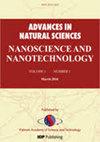Improved photocatalytic and free radical scavenging studies of synthesized polymer PVP/Azadirachta indica leave extract-mediated Ni-Zn doped hematite nanoparticles
IF 1.7
Q3 MATERIALS SCIENCE, MULTIDISCIPLINARY
Advances in Natural Sciences: Nanoscience and Nanotechnology
Pub Date : 2024-06-01
DOI:10.1088/2043-6262/ad50bb
引用次数: 0
Abstract
The utilisation of ecological materials, such as plant extracts, is a superior alternative to both physical and chemical techniques for the synthesis of nanoscale metallic particles. The current study concluded that the chemical polymer (PVP) and Azadirachta indica (A. indica) plant extract synthesised hematite nanoparticles (HNPs) were spherical, monodispersed, and served as an agent for reducing and capping. The pure HNPs with the most reliable rhombohedral symmetry were found to be crystalline thanks to the crisp x-ray diffraction (XRD) reflections. Spheroidal nanostructures were formed, as seen by scanning electron microscopy (SEM), and their composition was validated by an energy dispersive spectroscopy (EDS) study. At room temperature, HNPs were antiferromagnetic with blocking temperature of 300 K. When used as a catalyst, the NPs were exposed to effective degradation and coefficient of determination (R 2) of the toxic Eosin Yellow (EY) and Bismarck Brown Y (BBY) dyes in the presence of UV irradiation. After four consecutive cycles, efficient performance was achieved without any evident catalytic loss. Additionally, the reusability experiments revealed that under direct UV light illumination, duel-doped HNPs may be successfully used three times. The biosynthesised doped HNPs from A. indica leaf extract demonstrated antioxidant activity through their high phenolic and flavonoid contents, DPPH radical scavenging activity, and reductive potential.合成聚合物 PVP/Azadirachta indica leave 提取物介导的掺杂镍锌的赤铁矿纳米粒子的光催化和自由基清除性能改进研究
利用生态材料(如植物提取物)合成纳米级金属颗粒是物理和化学技术的一种优越替代方法。目前的研究认为,化学聚合物(PVP)和 Azadirachta indica(A. indica)植物提取物合成的赤铁矿纳米粒子(HNPs)呈球形,单分散,可作为还原剂和封端剂。通过清晰的 X 射线衍射 (XRD) 反射,我们发现具有最可靠斜方对称性的纯 HNPs 是结晶的。扫描电子显微镜(SEM)显示,球状纳米结构已经形成,能量色散光谱(EDS)研究验证了它们的组成。在室温下,HNPs 具有反铁磁性,阻滞温度为 300 K。将 HNPs 用作催化剂时,在紫外线照射下,可有效降解有毒的 Eosin Yellow(EY)和 Bismarck Brown Y(BBY)染料,并提高其测定系数(R 2)。经过连续四次循环后,该催化剂实现了高效性能,且未出现任何明显的催化损失。此外,可重复使用性实验表明,在紫外光直接照射下,双掺杂 HNPs 可成功使用三次。从 A. indica 叶提取物中生物合成的掺杂 HNPs 具有较高的酚类和类黄酮含量、DPPH 自由基清除活性和还原潜力,因而具有抗氧化活性。
本文章由计算机程序翻译,如有差异,请以英文原文为准。
求助全文
约1分钟内获得全文
求助全文
来源期刊

Advances in Natural Sciences: Nanoscience and Nanotechnology
NANOSCIENCE & NANOTECHNOLOGYMATERIALS SCIE-MATERIALS SCIENCE, MULTIDISCIPLINARY
自引率
4.80%
发文量
0
 求助内容:
求助内容: 应助结果提醒方式:
应助结果提醒方式:


